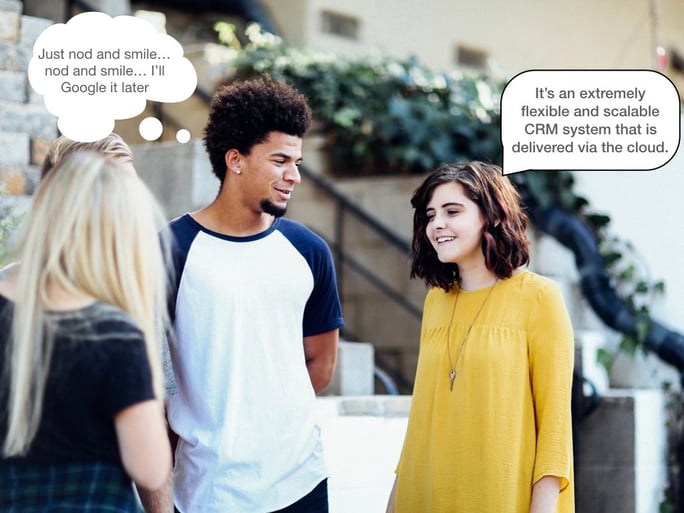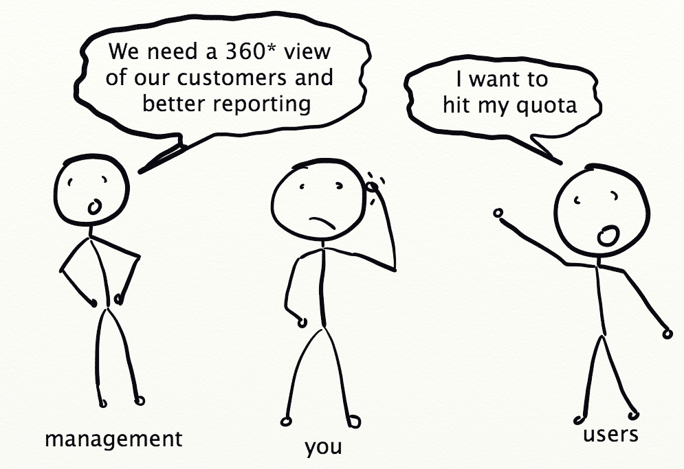
OK, that title is a little click-baity.
I haven't actually done scientific research that definitely states, "This is the #1 reason..."
So I apologize to statistical minds everywhere.
To make up for the title, I won't make you read the whole article before I jump to my point. I'll tell you right up front what the overlooked reason is. Then I'll go into some detail that backs up my assertion (and you'll probably agree that my title isn't too far off).
Here it is, the #1 overlooked reason your Salesforce training is a dud: You don't know what job Salesforce actually does for the end user.
You think you do. But you don't.
That's why it's easy to overlook. And as long as you aren't showing users how Salesforce helps them do their job better, they won't adopt it.
You're stuck in the middle
Figuring out what job Salesforce actually does for the end user is difficult because you're kind of stuck in the middle.

On one side, you have management. They bought Salesforce because of its promise to improve sales, give them a 360 view of customers, and see better reports (which will give them a strategic advantage, insights into the next trends, blah blah blah).
Management expects you to push their message to all of the end users.
On the other side, you have the end user. They didn't ask for Salesforce nor did they buy Salesforce. But nobody has asked them what they wanted. What they do on a day-to-day basis. Or what they struggle with.
Which means you're introducing a solution (and a message) to a problem they may not even know exists (or agree with).
Trainers use the wrong message
It's like trying to get my friend to use a Kindle by saying,
"Now you can read thousands of books!"
Only to have my friend stare back at me and say,
"But I don't care about reading thousands of books."
Even though my friend's wife purchased the Kindle with hopes that her husband would read more--he didn't actually think that he should read more.
So there the Kindle sits, collecting dust.
And that's where you are at. Management purchased Salesforce for the company with hopes that everybody would update it regularly so they could get killer reports.
So, you show up to Salesforce training and say,
"Now you can get better reporting!"
Only to have users stare back at you and say,
"But I don't care about better reporting."
Download this free eBook to help you improve Salesforce Training >> Click here to get it
You used a message that is exciting to managers. But that same message doesn't resonate with users.
So there Salesforce sits, collecting dust.
Trainers use no message at all
Not all trainers use the wrong message. Some trainers have no message at all.
Users show up to Salesforce training and are told how to functionally use Salesforce.
This is like giving your friend a Kindle and saying,
"Here's how to add books. Here's how to highlight passages. Here's how to borrow books."
Your friend has a vague idea of how to use the Kindle, but still isn't sure how or when he'll actually use it. He doesn't have any context.
Same thing happens in Salesforce training.
"Here's how to convert leads. Here's how to create a new account. Here's how a relational database works."
You deliver instructions without any context at all. Users have a vague idea of how to use Salesforce, but still aren't sure how or when they'll actually use it.
What Job Does Salesforce Help Users Do Better?
You need to figure out the current jobs users are doing, then show them how Salesforce helps them do it better.
Jobs to be done theory
In his latest book, Competing Against Luck, Clayton Christensen explains his "Jobs to be done" theory.
The theory states that people hire products to do a job for them.
An example of this was milkshakes. Clayton Christensen's team interviewed people buying milkshakes in the morning, and learned that customers were essentially hiring a milkshake to keep them occupied (and their tummies full) during the drive to work.
Customers had previously hired other products (bagels, muffins, yogurt), but didn't like them. Too messy, gone too fast, or didn't fill them up enough.
So they hired a milkshake each morning during their commute. The milkshake did a great job! No mess. Lasted all the way to work. And kept them filled up until the late morning.
So customers continued to hire milkshakes during their commute to work.
After the workday was over, however, customers still hired milkshakes. But this time, it was to do a different job.
After work, customers didn't care as much about the mess, they didn't care if the milkshake lasted a long time, and they didn't really care about the shake filling them up.
The reason customers were hiring milkshakes after work was because it was a simple way to finally say "Yes" to their kids without feeling too guilty.
Customers were "hiring" milkshakes at different times of the day to do different jobs.
Clayton Christensen points out that if we can figure out what jobs people want done, and then help those people do that job better, they will hire your product.
Applying that to Salesforce
Do you know what apps are being used by your workforce? Do you know how those apps are being used? Do you know the problems users face when they use them?
What are users doing to keep track of new leads?
What are they doing to manage projects?
How are they keeping track of which customers belong to which companies?
Once you identify what users are doing, you will be able to show them how Salesforce helps them do it better.
Show users why they should "hire" Salesforce
Let's jump back to the example of my friend and the Kindle.
What if, instead of expressing his wife's message ("You can read thousands of books"), I took time to understand what my friend could use the Kindle for?
After a brief discussion, I learn that my friend travels a lot for work and he enjoys reading magazines, blogs, the newspaper, and a couple of business books. He doesn't consider himself an avid reader, but it turns out that he actually does read a lot.
So, instead of introducing the Kindle with "Now you can read thousands of books!" I could introduce it to him this way,
"Remember when you told me how annoying it is to pack a newspaper, magazine, and a business book in your carry on when you travel for work? Well, I got you something that will take care of that. You'll never be bored while on the plane or waiting for a flight. You can also use it while you take a taxi to the hotel, hang out by the pool or the beach (I got it waterproofed), or while you're on the exercise bike."
In that context, I'm not telling my friend that he can read thousands of books—he doesn't care about that.
Instead, I'm explaining it to my friend in the context that makes sense to him—my friend uses books, magazines, newspapers, and blogs to pass the time while traveling for work. So I tell him about the benefits of Kindle as it relates to traveling for work.
You need to do that same thing for your Salesforce users.
Instead of explaining how reports are so wonderful (something that your management cares about), explain other aspects of Salesforce in the context of what they want to do.
"Remember when you told me that keeping track of leads, and following up with them, was a huge pain? Well, I got you something that will take care of that. Just click a button to see all of the leads you are currently working on, along with their status. You'll never lose track of leads again."
After all, the first step to better reporting (what management wants) is to get the right data into Salesforce in the first place. And the way you do that is by helping users understand what job Salesforce helps them do if they put in the correct data, and how Salesforce helps them do it better.
But the only way to know what users want to do is to ask them. And keep asking them until you get a clear picture of what jobs they are doing and what they are struggling with.
Once you understand your users' jobs, you'll have a better understanding of how to convince them that they should "hire" Salesforce to help them do that job even better.
Hiring Salesforce will improve adoption
People "hire: Facebook to deal with loneliness. People "hire" their iPhones to deal with boredom.
If you can get users to "hire" Salesforce to do their job better, you'll see adoption rise and user behavior change.
Download this free eBook to help you improve Salesforce Training >> Click here to get it
